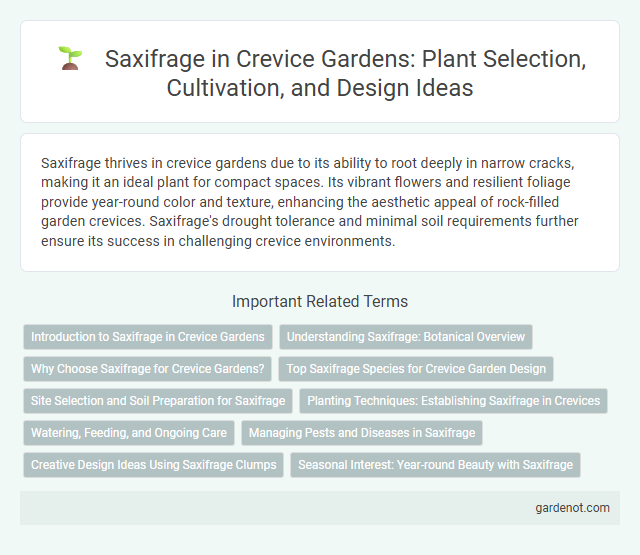Saxifrage thrives in crevice gardens due to its ability to root deeply in narrow cracks, making it an ideal plant for compact spaces. Its vibrant flowers and resilient foliage provide year-round color and texture, enhancing the aesthetic appeal of rock-filled garden crevices. Saxifrage's drought tolerance and minimal soil requirements further ensure its success in challenging crevice environments.
Introduction to Saxifrage in Crevice Gardens
Saxifrage is a key plant species well-suited for crevice gardens due to its natural ability to thrive in narrow, rocky spaces with minimal soil. This genus includes numerous hardy varieties that exhibit rosette formations and vibrant blooms, perfectly adapted to the microclimate of crevice environments. Its drought tolerance and preference for well-drained conditions make Saxifrage an ideal choice for enhancing the biodiversity and aesthetic appeal of crevice gardens.
Understanding Saxifrage: Botanical Overview
Saxifrage is a genus of perennial plants known for thriving in rocky, crevice garden environments, characterized by their rosette-forming leaves and star-shaped flowers. These plants exhibit remarkable adaptability to alpine and temperate climates, with over 400 species present globally, emphasizing their ecological diversity. Saxifrage species play a crucial role in stabilizing soil within crevices, contributing to biodiversity and aesthetic appeal in rock garden designs.
Why Choose Saxifrage for Crevice Gardens?
Saxifrage thrives in crevice gardens due to its exceptional ability to grow in rocky, well-drained environments with minimal soil. Its low, cushion-like growth habit and vibrant blooms add texture and color, enhancing the natural aesthetics of crevice landscapes. Saxifrage's drought tolerance and resilience to harsh conditions make it an ideal choice for sustainable, low-maintenance rock garden designs.
Top Saxifrage Species for Crevice Garden Design
Top saxifrage species ideal for crevice garden design include Saxifraga x urbium, known for its vibrant yellow flowers and versatility in rocky environments, and Saxifraga oppositifolia, which thrives in alpine crevices with its striking purple blooms. Saxifraga paniculata offers dense rosettes and delicate white flowers, making it a robust choice for crevice gardens requiring compact growth. These species enhance the aesthetic and ecological value of crevice gardens by flourishing in shallow soil and harsh conditions while providing year-round visual interest.
Site Selection and Soil Preparation for Saxifrage
Saxifrage thrives in crevice gardens with well-drained, gritty soil rich in organic matter, ideally composed of a mix of loam and sand to mimic alpine conditions. Site selection should prioritize partial shade and protection from harsh winds, ensuring consistent moisture without waterlogging. Proper soil preparation involves incorporating coarse gravel or small stones to enhance drainage and create microhabitats that retain moisture near the roots while preventing root rot.
Planting Techniques: Establishing Saxifrage in Crevices
Saxifrage thrives in crevice gardens by planting it in narrow gaps filled with well-draining, gritty soil to mimic its natural alpine environment. Ensuring the roots have adequate moisture without waterlogging promotes healthy growth while allowing excess water to escape. Positioning saxifrage in sheltered, sunlit crevices supports its tolerance for temperature fluctuations and enhances flowering.
Watering, Feeding, and Ongoing Care
Saxifrage thrives in crevice gardens with well-drained soil and requires moderate watering to keep the soil consistently moist but not waterlogged. Feeding with a balanced, slow-release fertilizer during the growing season promotes healthy growth and vibrant blooms. Ongoing care includes removing spent flowers and dead foliage to encourage new growth and prevent disease, ensuring the plant stays vigorous and attractive.
Managing Pests and Diseases in Saxifrage
Saxifrage plants benefit from well-drained soil and good air circulation to minimize pest and disease issues, including aphids and powdery mildew. Regular inspection and removal of affected leaves help control infestations, while insecticidal soaps or neem oil can be applied for severe pest problems. Implementing crop rotation and avoiding overhead watering reduce fungal diseases, promoting healthy growth in crevice gardens.
Creative Design Ideas Using Saxifrage Clumps
Saxifrage clumps, with their dense, low-growing habit and vibrant rosettes, create striking textural contrasts when nestled in the crevices of rock gardens. Integrating various Saxifrage species, such as Saxifraga paniculata and Saxifraga urbium, enhances visual interest through diverse leaf shapes and subtle flower hues. Strategic placement among stones maximizes moisture retention and creates naturalistic, moisture-loving microhabitats essential for thriving crevice garden designs.
Seasonal Interest: Year-round Beauty with Saxifrage
Saxifrage offers year-round beauty in crevice gardens through its evergreen foliage and delicate blossoms that bloom from spring to autumn. Its ability to thrive in rocky, well-drained crevices ensures continuous seasonal interest with vibrant colors and textures. Winter brings visual appeal as some saxifrage species develop attractive red or bronze hues, maintaining garden charm throughout all seasons.
Saxifrage Infographic

 gardenot.com
gardenot.com